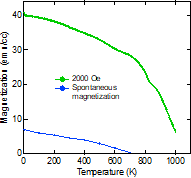第122回フロンティア材料研究所講演会 (若林勇希博士)
| 開催日時 | 2020年01月28日 15:00 - |
|---|---|
| 開催場所 | R3棟6階セミナー室 |
| 主催 | フロンティア材料研究所 |
| 連絡先 | 東・山本研究室(5315) |
プログラム等
講師: 若林 勇希 博士
(NTT物性科学基礎研究所)
演題: Molecular beam epitaxy and utilization of machine learning for development of novel and high-quality 4d and 5d magnetic oxides
講演概要:
Magnetic oxides are typically 3d transition metal oxides where spin-orbit coupling (SOC) is tiny, while an enhancement of the SOC in 4d and 5d systems may enrich variety of fascinating magnetic materials. Recently, we have developed a novel 5d perovskite Sr3OsO6 (FM insulator) and improved the material quality of a 4d perovskite SrRuO3 (FM metal) by using a unique molecular beam epitaxy (MBE) technique.
First, we show that the highly B-site ordered cubic double-perovskite Sr3OsO6 has the highest Curie temperature (TC) of ~1060 K among all insulators and oxides1) (Fig. 1). Resistivity and optical measurements revealed that Sr3OsO6 is an insulator with the band gap of 2.65 eV. Density-functional-theory calculations also elucidated the ferromagnetic ground state of Sr3OsO6, where the large SOC of the Os6+ 5d2 orbitals drives the system toward an insulating state with Jeff = 3/2. Sr3OsO6 is expected to be readily implemented in high-performance magnetic devices that work above room temperature.
Second, we demonstrate a machine-learning-assisted MBE growth of SrRuO32,3). To simplify the intricate search space of entangled growth conditions, we ran the Bayesian optimization (BO) for a single growth condition while keeping the other growth conditions fixed. As a result, a high-crystalline-quality SrRuO3film exhibiting a high residual resistivity ratio (RRR) of over 50 as well as strong perpendicular magnetic anisotropy was developed in only 24 MBE growth runs. Our BO-based search method provides an efficient experimental design that is not as dependent on the experience and skills of individual researchers, and it reduces experimental time and cost, which will accelerate materials research.

References:
1) Y. K. Wakabayashi, et al., Nat. Commun. 10, 535 (2019).
2) Y. K. Wakabayashi, et al., Appl. Phys. Express 11, 112401 (2018).
3) Y. K. Wakabayashi, et al., APL Materials 7, 101114 (2019).
